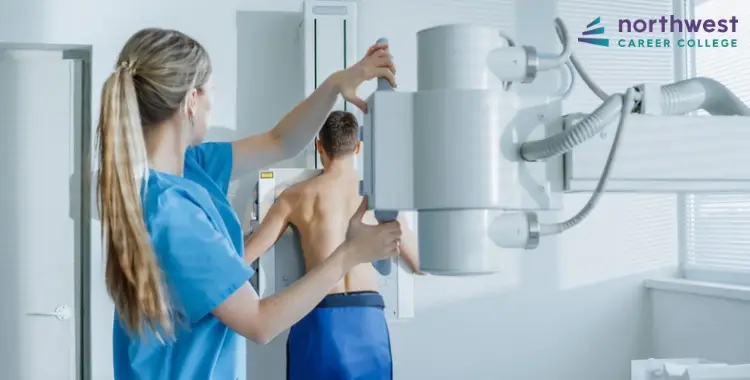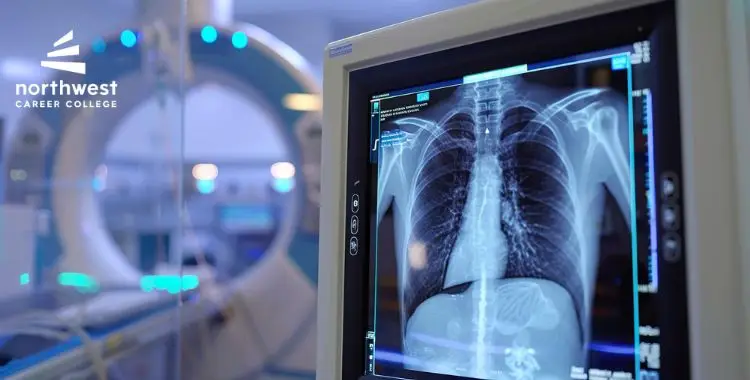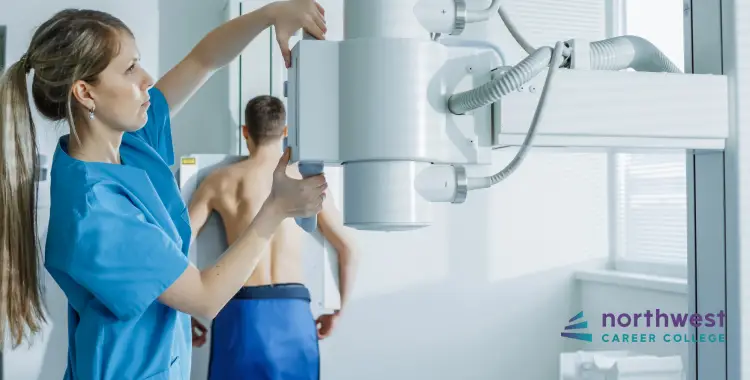Digital vs. Traditional Radiography: What Students Should Know
- March 12, 2024
- 3.0k views
- 4 min read

The digital transition permeating our economy has impacted practically every industry over the past 30 years. Radiography is no different.
Understanding the differences between digital and traditional videography is crucial for the success of students seeking to enter the radiography field. This knowledge helps new industry professionals grasp how technology has evolved and its impact on patient care.
Table of Contents
Digital versus Traditional Radiography
Defining digital and traditional radiography is the best place to start for those new to the industry.
Traditional radiography utilizes film to capture x-ray images. This film must be developed in a dark room and stored in hardcopy in a filing system. This is similar to traditional photography.
Digital radiography, on the other hand, still relies upon the same X-rays as traditional radiography but utilizes digital sensors to capture the associated images. Images do not need to be developed, and storage automatically occurs in a digital format.
Radiation Exposure
Traditional radiography is safe but exposes patients to higher radiation levels than new, emerging digital methods. This is due to the increased radiation needed to create the images on traditional film.
Digital radiography, in contrast, requires significantly less radiation due to the greater sensitivity of digital sensors compared with traditional film. Some estimates indicate that digital radiography can generate 80% less radiation.
Reducing radiation exposure to patients makes digital radiography a safer option for most procedures, especially for patients who require frequent imaging to manage their medical conditions.
Cost-Effectiveness and Efficiency
Traditional radiography has higher long-term costs than digital radiography due to its reliance on disposable materials. Traditional radiography relies upon film, which must be purchased for each x-ray exposure, and various chemicals are required to develop that film.
Digital radiography, in contrast, requires high upfront costs associated with the purchase of digital sensors. However, it is more affordable in the long run due to the absence of ongoing film and development fluid costs.
Additionally, digital images are produced and displayed instantaneously, enhancing human resources efficiencies by reducing the time spent on capturing X-rays, developing X-rays, and recapturing X-rays that were insufficient for diagnostic purposes.
Storage and image quality
Traditional radiography presents challenges related to storage and image quality. Storage of analog film can be challenging because it is not space-efficient and does not align with the transition of most medical practices and hospitals to electronic medical records.
Additionally, traditional radiography presents diagnostic challenges. The image quality naturally degrades over time. Further, analog film is generally incompatible with the resizing of images, as doing so typically leads to the loss of image quality.
Digital radiography, by contrast, offers virtually unlimited storage space at low fixed costs. It also provides practices in hospitals, the ability to transfer images to hard drives for longer-term cold storage. Digital images maintain quality over time and can be easily resized without distortion.
Overall, the features available in computer software provide an entirely different level of diagnostic capability.
Environmental impact
Traditional radiography uses film and various chemicals for development, all of which have an environmental impact on their disposal. The film ends up in a landfill, while chemicals used for traditional radiography may be toxic and must be disposed of through biohazard processing.
Digital radiography, by contrast, is more environmentally friendly, as it does not require film or chemicals to develop images. Digital sensors eventually wear out, but they only do so after a significant number of uses and overall reduce waste related to radiography.
Artificial intelligence
Traditional videography cannot easily take advantage of advances in artificial intelligence, as the film produced by traditional radiography would need to be scanned And uploaded in a digital format before artificial intelligence models could analyze it. This methodology is inefficient for human resources reasons and will likely produce low-quality images of limited diagnostic value.
Digital radiography, by contrast, is ideally situated to take advantage of new capabilities and artificial intelligence. Many radiology practices use artificial intelligence to analyze digital images and produce preliminary diagnostic information to support their radiologists.
Conclusion
The transition from traditional to digital radiography is well underway and well justified. This transition has significant benefits and few downsides besides the upfront cost required to invest in digital videography solutions.
The advantages, such as reduced radiation, exposure, cost, effectiveness, image, quality, environmental benefits, and diagnostic capabilities outweigh any downside risks. Technology in this industry will continue to evolve, so current and future healthcare professionals must stay informed about advancements in digital radiography in the coming years.




